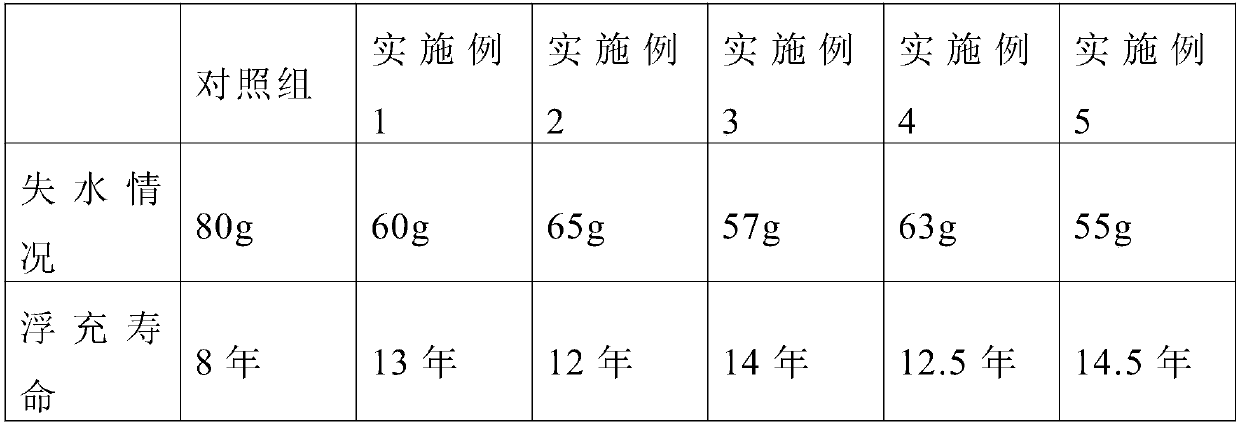Lead-acid battery positive-grid low antimony alloy
A technology of lead-acid batteries and antimony alloys, which is applied in the direction of lead-acid battery electrodes, battery electrodes, circuits, etc., can solve the problems of easy water loss, good corrosion resistance and electrical conductivity, and low hydrogen evolution overpotential, so as to reduce serious water loss, Improved corrosion resistance and durability, simple preparation process
- Summary
- Abstract
- Description
- Claims
- Application Information
AI Technical Summary
Problems solved by technology
Method used
Image
Examples
Embodiment 1
[0020] A low-antimony alloy for the positive grid of a lead-acid storage battery, comprising the following components in weight percentages:
[0021] Manganese 0.07%, silver 0.008%, tin 0.09%, antimony 1.2%, ytterbium 0.08%, and the balance is lead.
[0022] According to the proportioning of the above-mentioned grid alloy, the preparation method is as follows:
[0023] Step 1. Divide the lead into two parts. One part of lead is melted at 450-470°C, and the other part is used; after the lead is melted, a part of tin is added. After it is completely melted, stir evenly, and when it is lowered to 500-550°C, take it out of the furnace to obtain lead-antimony-tin alloy;
[0024] Step 2: Melt ytterbium in a high-temperature furnace at 950°C. After it is completely melted, raise the temperature to 1000-1100°C, and then add silver. After it is completely melted, stir evenly; Ytterbium alloy;
[0025] Step 3. Put another part of lead into the lead pot, and heat up to 450-470°C to me...
Embodiment 2
[0028] A low-antimony alloy for the positive grid of a lead-acid storage battery, comprising the following components in weight percentages:
[0029] Manganese 1.3%, silver 0.005%, tin 0.06%, antimony 2.0%, ytterbium 0.08%, lanthanum 0.04%, and the balance is lead.
[0030] According to the proportioning of the above-mentioned grid alloy, the preparation method is as follows:
[0031] Step 1. Divide the lead into two parts. One part of lead is melted at 450-470°C, and the other part is used; after the lead is melted, a part of tin is added. After it is completely melted, stir evenly, and when it is lowered to 500-550°C, take it out of the furnace to obtain lead-antimony-tin alloy;
[0032] Step 2: Melt ytterbium and lanthanum in a high-temperature furnace at 950°C. After complete melting, heat up to 1000-1100°C, then add silver, and stir evenly after it is completely melted; Obtain silver ytterbium lanthanum alloy;
[0033] Step 3: Put another part of lead into the lead pot...
Embodiment 3
[0036] A low-antimony alloy for the positive grid of a lead-acid storage battery, comprising the following components in weight percentages:
[0037] Manganese 1.2%, silver 0.007%, tin 0.08%, antimony 1.5%, ytterbium 0.07%, samarium 0.02%, and the balance is lead.
[0038] According to the proportioning of the above-mentioned grid alloy, the preparation method is as follows:
[0039] Step 1. Divide the lead into two parts. One part of lead is melted at 450-470°C, and the other part is used; after the lead is melted, a part of tin is added. After it is completely melted, stir evenly, and when it is lowered to 500-550°C, take it out of the furnace to obtain lead-antimony-tin alloy;
[0040] Step 2: Melt ytterbium and samarium in a high-temperature furnace at 950°C. After melting completely, raise the temperature to 1000-1100°C, then add silver, and stir evenly after it is completely melted; Obtain silver ytterbium samarium alloy;
[0041] Step 3: Put another part of lead into...
PUM
 Login to View More
Login to View More Abstract
Description
Claims
Application Information
 Login to View More
Login to View More - R&D
- Intellectual Property
- Life Sciences
- Materials
- Tech Scout
- Unparalleled Data Quality
- Higher Quality Content
- 60% Fewer Hallucinations
Browse by: Latest US Patents, China's latest patents, Technical Efficacy Thesaurus, Application Domain, Technology Topic, Popular Technical Reports.
© 2025 PatSnap. All rights reserved.Legal|Privacy policy|Modern Slavery Act Transparency Statement|Sitemap|About US| Contact US: help@patsnap.com

